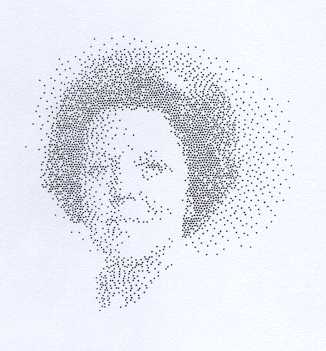

Result of the transformation of photo "1". Portrait is perhaps a bit too severe and elevated. The total image is asymmetrical.

Result of the transformation of photo "2". A diademe and a smile which is a bit too frivolous and friendly. The wall paper on the background disturbs the image.

Result of the transformation of photo "3". Definitive choice. The postage stamp lettering still needs to be added.
Definitive division of image dots.
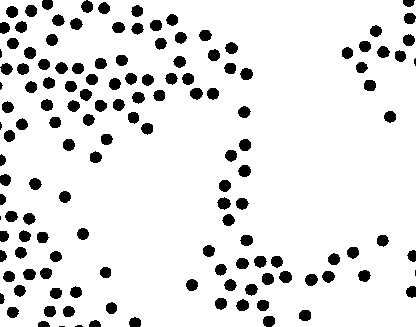
Result of the transformation of photo "3". This is an imperfect enlargement. One should image the dots to be perfectly round. The central part of the postage stamp with dots representing Queen Beatrix's eyes and nose. Representing is not really the correct term. The image represents and leads a life of its own. It shows the sitter's skin and at the same time it is an image in itself - removed from the skin.
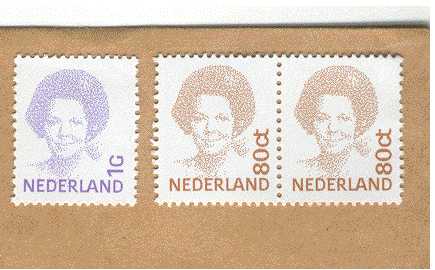
 Struycken,
in an interview with Hefting: "In designing
the postage stamp and its portrait section in particular I use the
least associative and least meaningful elements I know of - the space
between dots. Generally visual images can be conjured by either
densely grouping or thinning out of dots. The dots themselves do not
refer to an outside reality. As a designer I am fascinated by the
similarity of some of the dots with Beatrix, thus generating a
specific meaning."
Struycken,
in an interview with Hefting: "In designing
the postage stamp and its portrait section in particular I use the
least associative and least meaningful elements I know of - the space
between dots. Generally visual images can be conjured by either
densely grouping or thinning out of dots. The dots themselves do not
refer to an outside reality. As a designer I am fascinated by the
similarity of some of the dots with Beatrix, thus generating a
specific meaning."
In the summer of 2000 Struycken writes to Kaldenbach: "My use of dots in the representation of the portrait is related to my drawings and prints in which the dot is the smallest representation of colour and in itself, yields the least association with form. Generally this characteristic is of central importance in my work." [trans. KK]
Two relatively recent portreits of the Queen are in fact a futher development of the "Queens' Stamps".
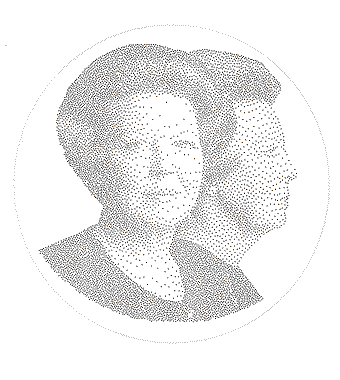
1997 is the date of the portrait made by Struycken for the State Auditor's Camber (Rekenkamer) in The Hague, designed by architect Aldo van Eyck. Together with him Strucken defined the placement and size of the portrait. The design shown here is the final art work. The size of the slightly dome-shaped glass plate is 156 cm, and the picture was silk-screened onto it - in dark blue.
The queen had this portrait printed in sevaral celebration brochures in 1998 in order to mark het birthday.

Photo of the art object in situ in the Rekenkamer hall by photographer Levien Willemse.
 Ministery
of Health and Sports, The Hague
Ministery
of Health and Sports, The HagueAn other design is a portret of the Queen in the new ministery of Health and Sports (ministerie van VWS) in The Hague. The architect of this building was Michael Graves. In collaboration with him Struycken defined the exact place of the portrait: between the escalators to the first floor. Tha portrait has been spray painted on a flat surface and measures 122 cm.
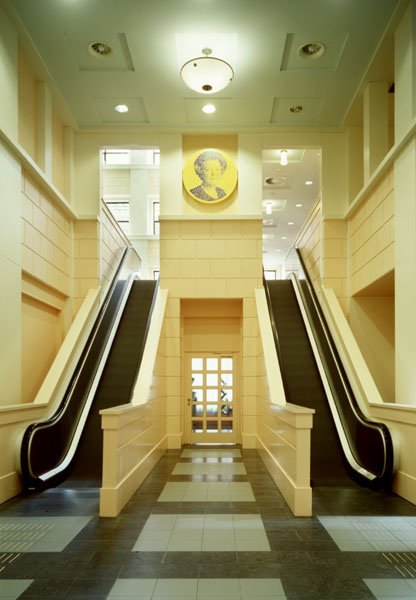
The work of art in situ. Photograph by Joop van Reken Studio.
All of the above illustrations have been reproduced with the permission of Peter Struycken and his Copyright Bureau Stichting Beeldrecht, Amsterdam. Their basic copyright remains intact even on internet. If you plan to store or re-use images please contact them and obtain their permission.
Back to the discussion of the design process of the postage stamp.
A letter by Struycken on Vermeer.
Computers & Design: See V2 Institute for instable media.
See also High School of Arts & Design, Utrecht.
Heimat far another combination of art & technology.
More about the author Kaldenbach click author.
Page launched summer 2000. Last update 27 September 2001.